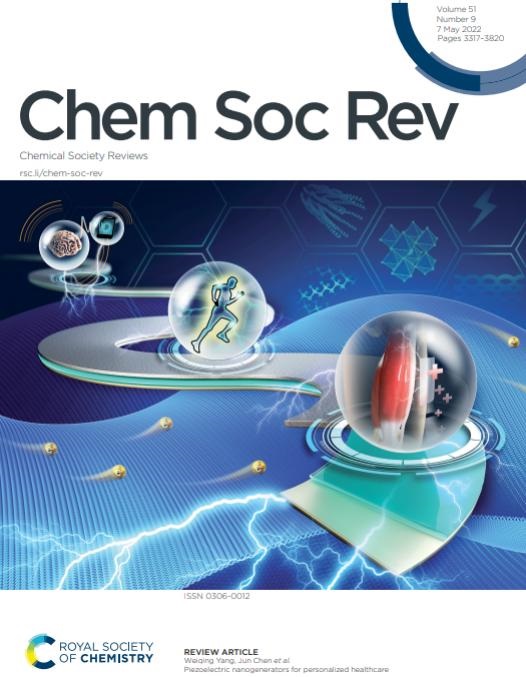Cuproptosis: mechanisms and nanotherapeutic strategies in cancer and beyond
IF 40.4
1区 化学
Q1 CHEMISTRY, MULTIDISCIPLINARY
引用次数: 0
Abstract
Cuproptosis, a novel form of copper (Cu)-dependent programmed cell death, is induced by directly binding Cu species to lipoylated components of the tricarboxylic acid (TCA) cycle. Since its discovery in 2022, cuproptosis has been closely linked to the field of materials science, offering a biological basis and bright prospects for the use of Cu-based nanomaterials in various disease treatments. Owing to the unique physicochemical properties of nanomaterials, Cu delivery nanosystems can specifically increase Cu levels at disease sites, inducing cuproptosis to achieve disease treatment while minimizing the undesirable release of Cu in normal tissues. This innovative nanomaterial-mediated cuproptosis, termed as “nanocuproptosis”, positions at the intersection of chemistry, materials science, pharmaceutical science, and clinical medicine. This review aims to comprehensively summarize and discuss recent advancements in cuproptosis across various diseases, with a particular focus on cancer. It delves into the biochemical basis of nanomaterial-mediated cuproptosis, the rational design for cuproptosis inducers, strategies for enhancing therapeutic specificity, and cuproptosis-centric synergistic cancer therapeutics. Beyond oncology, this review also explores the expanded applications of cuproptosis, such as antibacterial, wound healing, and bone tissue engineering, highlighting its great potential to open innovative therapeutic strategies. Furthermore, the clinical potential of cuproptosis is assessed from basic, preclinical to clinical research. Finally, this review addresses current challenges, proposes potential solutions, and discusses the future prospects of this burgeoning field, highlighting cuproptosis nanomedicine as a highly promising alternative to current clinical therapeutics.

铜增生:癌症及其他疾病的机制和纳米治疗策略
cuprotosis是一种新型的铜(Cu)依赖性程序性细胞死亡,它是通过直接将Cu物种与三羧酸(TCA)循环的脂化组分结合而诱导的。自2022年发现铜钛以来,铜钛一直与材料科学领域紧密联系在一起,为铜基纳米材料在各种疾病治疗中的应用提供了生物学基础和光明前景。由于纳米材料独特的物理化学性质,铜递送纳米系统可以特异性地增加疾病部位的铜水平,诱导铜还原以实现疾病治疗,同时最大限度地减少正常组织中铜的不良释放。这种创新的纳米材料介导的铜移植,被称为“纳米铜移植”,处于化学、材料科学、制药科学和临床医学的交叉点。这篇综述旨在全面总结和讨论最近在各种疾病中的进展,特别关注癌症。它深入研究了纳米材料介导的铜增生的生化基础,铜增生诱导剂的合理设计,提高治疗特异性的策略,以及以铜增生为中心的协同癌症治疗方法。除肿瘤学外,本文还探讨了铜异体的广泛应用,如抗菌、伤口愈合和骨组织工程,强调其在开辟创新治疗策略方面的巨大潜力。此外,从基础研究、临床前研究到临床研究,对铜骨畸形的临床潜力进行了评估。最后,本文回顾了当前的挑战,提出了潜在的解决方案,并讨论了这一新兴领域的未来前景,强调了铜突起纳米医学作为当前临床治疗的一个非常有前途的替代方案。
本文章由计算机程序翻译,如有差异,请以英文原文为准。
求助全文
约1分钟内获得全文
求助全文
来源期刊

Chemical Society Reviews
化学-化学综合
CiteScore
80.80
自引率
1.10%
发文量
345
审稿时长
6.0 months
期刊介绍:
Chemical Society Reviews is published by: Royal Society of Chemistry.
Focus: Review articles on topics of current interest in chemistry;
Predecessors: Quarterly Reviews, Chemical Society (1947–1971);
Current title: Since 1971;
Impact factor: 60.615 (2021);
Themed issues: Occasional themed issues on new and emerging areas of research in the chemical sciences
 求助内容:
求助内容: 应助结果提醒方式:
应助结果提醒方式:


